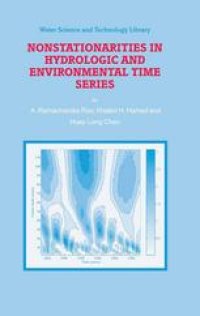
Ebook: Nonstationarities in Hydrologic and Environmental Time Series
- Tags: Hydrogeology, Systems Theory Control, Mathematical Modeling and Industrial Mathematics, Statistics general
- Series: Water Science and Technology Library 45
- Year: 2003
- Publisher: Springer Netherlands
- Edition: 1
- Language: English
- pdf
Conventionally, time series have been studied either in the time domain or the frequency domain. The representation of a signal in the time domain is localized in time, i.e . the value of the signal at each instant in time is well defined . However, the time representation of a signal is poorly localized in frequency , i.e. little information about the frequency content of the signal at a certain frequency can be known by looking at the signal in the time domain . On the other hand, the representation of a signal in the frequency domain is well localized in frequency, but is poorly localized in time, and as a consequence it is impossible to tell when certain events occurred in time. In studying stationary or conditionally stationary processes with mixed spectra , the separate use of time domain and frequency domain analyses is sufficient to reveal the structure of the process . Results discussed in the previous chapters suggest that the time series analyzed in this book are conditionally stationary processes with mixed spectra. Additionally, there is some indication of nonstationarity, especially in longer time series.
This book presents a number of new techniques that have been discussed in the literature during the last two decades concerning the investigation of stationarity, linearity and Gaussianity of hydrologic and environmental times series. These techniques cover different approaches for assessing nonstationarity, ranging from time domain analysis, to frequency domain analysis, to the combined time-frequency and time-scale analyses, to segmentation analysis, in addition to formal statistical tests of linearity and Gaussianity. It is hoped that this endeavor would facilitate further research into this important area.
This book presents a number of new techniques that have been discussed in the literature during the last two decades concerning the investigation of stationarity, linearity and Gaussianity of hydrologic and environmental times series. These techniques cover different approaches for assessing nonstationarity, ranging from time domain analysis, to frequency domain analysis, to the combined time-frequency and time-scale analyses, to segmentation analysis, in addition to formal statistical tests of linearity and Gaussianity. It is hoped that this endeavor would facilitate further research into this important area.
Content:
Front Matter....Pages i-xxvii
Introduction....Pages 1-3
Data Used in the Book....Pages 4-26
Time Domain Analysis....Pages 27-55
Frequency Domain Analysis....Pages 56-114
Time-Frequency Analysis....Pages 115-159
Time-Scale Analysis....Pages 160-212
Segmentation of Non-Stationary Time Series....Pages 213-252
Estimation of Turbulent Kinetic Energy Dissipation....Pages 253-276
Segmentation of Observed Data....Pages 277-311
Linearity and Gaussianity Analysis....Pages 312-319
Bayesian Detection of Shifts in Hydrologic Time Series....Pages 320-346
References....Pages 347-357
Back Matter....Pages 359-365
This book presents a number of new techniques that have been discussed in the literature during the last two decades concerning the investigation of stationarity, linearity and Gaussianity of hydrologic and environmental times series. These techniques cover different approaches for assessing nonstationarity, ranging from time domain analysis, to frequency domain analysis, to the combined time-frequency and time-scale analyses, to segmentation analysis, in addition to formal statistical tests of linearity and Gaussianity. It is hoped that this endeavor would facilitate further research into this important area.
Content:
Front Matter....Pages i-xxvii
Introduction....Pages 1-3
Data Used in the Book....Pages 4-26
Time Domain Analysis....Pages 27-55
Frequency Domain Analysis....Pages 56-114
Time-Frequency Analysis....Pages 115-159
Time-Scale Analysis....Pages 160-212
Segmentation of Non-Stationary Time Series....Pages 213-252
Estimation of Turbulent Kinetic Energy Dissipation....Pages 253-276
Segmentation of Observed Data....Pages 277-311
Linearity and Gaussianity Analysis....Pages 312-319
Bayesian Detection of Shifts in Hydrologic Time Series....Pages 320-346
References....Pages 347-357
Back Matter....Pages 359-365
....